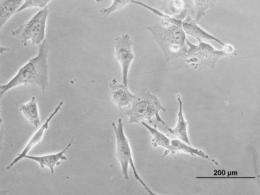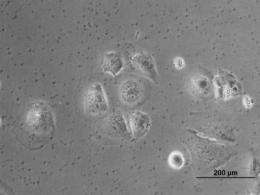Discovery may lead to turning back the clock on ovarian cancer

Cancer researchers have discovered that a type of regulatory RNA may be effective in fighting ovarian cancer. Ovarian cancer isn't typically discovered until it's in the advanced stages, where it is already spreading to other organs and is very difficult to fight with chemotherapy. This new discovery may allow physicians to turn back the clock of the tumor's life cycle to a phase where traditional chemotherapy can better do its job.
Scientists at the Ovarian Cancer Institute Laboratory at the Georgia Institute of Technology have found in initial tests that a regulatory RNA called miR-429 may be successful in inducing metastatic or spreading cancer cells to convert back to a less metastatic, non-invasive form. The research appears online in the journal Gynecologic Oncology.
"Primary tumors are rarely fatal," said John F. McDonald, director of the Integrated Cancer Research Center in Georgia Tech's School of Biology and chief research scientist at the Ovarian Cancer Institute. "Most cancer patients succumb because the cancer metastasizes, and current chemotherapies are not designed to kill metastasizing cancer cells."
Cancer cells exist in two forms: epithelial cancer cells and mesenchymal cancer cells. The primary tumor is mostly comprised of rapidly dividing epithelial cancer cells that are "sticky" so they stay together, they're not mobile and generally not invasive. Cells at the edge of tumors often change into mesenchymal cancer cells; they lose their adhesiveness and become highly mobile and invasive, allowing the cancer to spread, or metastasize, to other areas of the body.

In the new trial, McDonald's lab used two ovarian cancer cell lines, one with epithelial characteristics, like primary tumor cells, and the other with mesenchymal traits, like metastasizing cancer cells. They used miR-429, one of a family of microRNAs previously implicated in epithelial to mesencymal changes in other cancers, to see if it could turn the mesenchymal cancer cells back into epithelial cancer cells. They found that miR-429 was highly successful in helping cells turn back the clock.
"We found that when we introduced miR-429 into the highly metastatic ovarian cancer cells, they became less invasive, less migratory and more like the cancer cells associated with primary tumors," said McDonald.
Currently the McDonald lab is testing to see if cells that have been treated with miR-429 to change from mesenchymal to epithelial cancer cells are more susceptible to chemotherapy than metastasizing cells that haven't undergone this change.

"We are hopeful that we have found an effective way to drive metastasizing ovarian cancer cells back to their primary cancer stage where they can be more effectively treated with existing chemotherapies." added McDonald.















